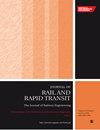基于多重回归模型的轨道纵向水平加速度状态监测
IF 1.7
4区 工程技术
Q3 ENGINEERING, CIVIL
Proceedings of the Institution of Mechanical Engineers Part F-Journal of Rail and Rapid Transit
Pub Date : 2023-09-14
DOI:10.1177/09544097231201513
引用次数: 0
摘要
本文介绍了一种轨道几何形态状态监测系统。该方法是为高速应用而设计的,在高速应用中,列车在大部分行程中以最大允许速度行驶。该系统的设计依赖于现役车辆记录的加速度数据,根据预建的回归模型提供轨道纵向水平的估计。它利用在100米长的预定义轨道段上采样的综合指标。考虑了不同的预测因子,从加速度数据和诊断列车测量的轨道几何来计算。所提出的建模策略允许区分分布在铁路轨道上的孤立缺陷和分布缺陷,并重现在考虑的轨道段中记录的最大纵向水平随时间的演变;此外,还对缺陷幅度进行了准确的预测。结果与诊断列车在2年监测期间记录的轨道几何数据进行了验证。事实证明,所提出的系统可以支持当前的维护策略,提供连续的数据流来监控轨道基础设施。本文章由计算机程序翻译,如有差异,请以英文原文为准。
Acceleration-based condition monitoring of track longitudinal level using multiple regression models
In this paper, a condition monitoring system for railway track geometry is presented. The methodology has been designed for high-speed application, where the train travels at the maximum allowed speed for most of the trip. The system is designed to rely on acceleration data recorded by in-service vehicles to provide estimations of the track longitudinal level, based on pre-built regression models. It exploits synthetic indicators sampled over predefined track sections 100 m long. Different predictors are considered, computed both from acceleration data and from track geometry measured by the diagnostic train. The proposed modelling strategy allows distinguishing between isolated and distributed defects that populate the railway track as well as reproducing the evolution over time of the maximum longitudinal level registered in the considered track section; moreover, also accurate predictions of the defect amplitude are made. The results have been validated against track geometry data recorded by the diagnostic train during a monitoring period of 2 years. It is proven that the proposed system could support current maintenance strategies, providing a continuous flow of data to monitor the track infrastructure.
求助全文
通过发布文献求助,成功后即可免费获取论文全文。
去求助
来源期刊

CiteScore
4.80
自引率
10.00%
发文量
91
审稿时长
7 months
期刊介绍:
The Journal of Rail and Rapid Transit is devoted to engineering in its widest interpretation applicable to rail and rapid transit. The Journal aims to promote sharing of technical knowledge, ideas and experience between engineers and researchers working in the railway field.
 求助内容:
求助内容: 应助结果提醒方式:
应助结果提醒方式:


